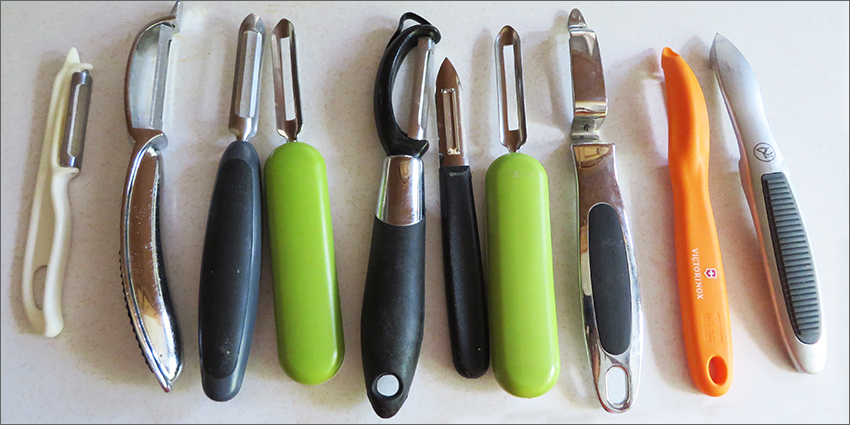When you start clutter clearing your home, it works best to begin with general household items. Get some easy successes under your belt before tackling more challenging types of things.
Most people have far less emotional attachment to general household items than to belongings of a more personal nature, so they are much easier to sort through. It also works best to begin with small, finite areas, so that you can get some small successes before tackling larger, more challenging areas.
And where you can easily find small areas of general household clutter? In your kitchen drawers, of course!
How many carrot peelers does a person really need?
If it’s been a while since you sorted through your kitchen drawers, don’t be surprised if some unexpected items emerge. The astonishing number of carrot peelers pictured here, for example, were found in the drawer of a woman who took my Fast Track Clutter Clearing course and gave me permission to include her photo in this article.
After having a good chuckle about how on earth she had acquired so many, she kept the three she liked the best and donated the others to charity, to start a new life peeling carrots in other people’s home rather than being allowed to continue languishing in hers.
How to sort through your kitchen drawers
Follow these seven steps:
1. Work drawer by drawer
Don’t pull everything out and attempt to do your entire kitchen in one go. Do one drawer at a time in 20-minute time boxes. Set a timer and begin.
2. Group similar things together
Begin by sorting everything into types so that you can see how many of each kind you have.
It’s a good idea to have a Charity box on hand for items you no longer need, a Recycling box for anything that can be recycled, and a Rubbish bin for things that have gone beyond the point of usefulness to you or anyone else.
If you come across things that don’t belong in your kitchen drawers, don’t interrupt what you’re doing to take them to where they belong. That’s a sure way to get distracted and end up doing something else. Instead, put them in a Transit box or container of some kind, and wait until the end of the session to take them to where they live.
3. Decide what to keep and what to let go
Use The Clutter Test for this. Ask yourself:
- Does it lift my energy when I think about it or look at it?
- Do I absolutely love it?
- Is it genuinely useful?
If you don’t get a yes to the first question and an equally resounding yes to either question 2 or 3, then the item is probably clutter. If you’re still not sure, ask yourself:
If I absolutely love it…
Does it really inspire me, or is it just “nice”?
Do I already have enough of this type of item for my needs?
In spite of how much I love it, does it also have sad associations in my life?
If it’s genuinely useful…
When did I actually last use it?
When, realistically, am I likely to use it again?
4. Clean each drawer
Use a damp cloth to clean each drawer before you start putting anything back. Get rid of all those crumbs and other bits of food and grime that somehow end up in there.
5. Use drawer organizers
There are some great solutions these days for organizing things in drawers. Just google “drawer organizers” to find what’s available in your part of the world. They’re not expensive and make a huge difference. They allow you to keep similar things together instead of all mixed up with everything else, which saves you time and frustration because you can easily find what you want when you need it.
6. Store things near to where you use them
As you put things back in your drawers, check that you’re storing things in the best locations. It’s amazing how many people quickly unpack when they arrive in a new home and leave it like that forever. Sometimes all it takes is to switch two drawers and everything works much better.
Keep the items you use most often at the front and at an easily reachable height, and keep the things you use less often at the back or in less easily reachable locations. What this really means, is that you keep the good stuff where you can get your hands on it and put the rest where most of it can morph into clutter over time. Ah well, at least it’s more organized now!
7. Let go of anything you no longer need
Decide whether to give, sell, re-purpose or throw away any items you no longer need. And set yourself a deadline for getting them out of your home, within a week at the most. Otherwise you’ll just be moving clutter from one location to another, and you don’t want that.
Kitchen cabinets
After you’ve worked through your kitchen drawers, work through your kitchen cabinets, one shelf at a time, using the same techniques.
General household clutter
You can clutter clear your entire home, 20 minutes at a time, using these methods and adding extra boxes, such as a Selling box, if you have items that can be sold, or a Returns box for items you have borrowed that need to be returned.
If you’d like to know more, the full 10-box system is described in detail in Chapter 16 of my book Clear Your Clutter with Feng Shui book, and a more concise 5-box system can be found in this free ebook How to Clear Your Clutter.
Copyright © Clear Space Living 2017, updated 2023
Related articles
How to clutter clear your home 20 minutes at a time
How to use The Clutter Test
Need help?
Online clutter clearing courses
Like to read more articles like this?
Subscribe to my newsletters to receive news, articles and information about upcoming online courses by email. And I promise you – no junk mail ever.





Hi Karen,
I just read this article and had to smile. I’ve done several KK courses this year; yesterday I noticed that the cosmetics’ section of my bathroom cabinet needed decluttering. I put on some music and spent a pleasant couple of hours with a pot of tea at a sunny table, sorting and reorganising, and now have sparkling cabinet shelves and easy-reach make-up articles, that saved me a lot of time this morning. I’ve just read the above article, and realise that I’ve internalised points 1 to 7, they now come naturally to me, and give me direction, and confidence. I would wish the same for everyone with clutter struggles.
Sue M
Where can I find your articles about clearing sentimental items. Thank
Hi Pat – Here’s a link to my cornerstone article about this topic: The problem with sentimental clutter.